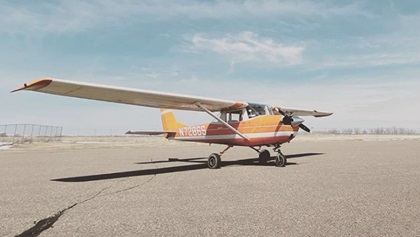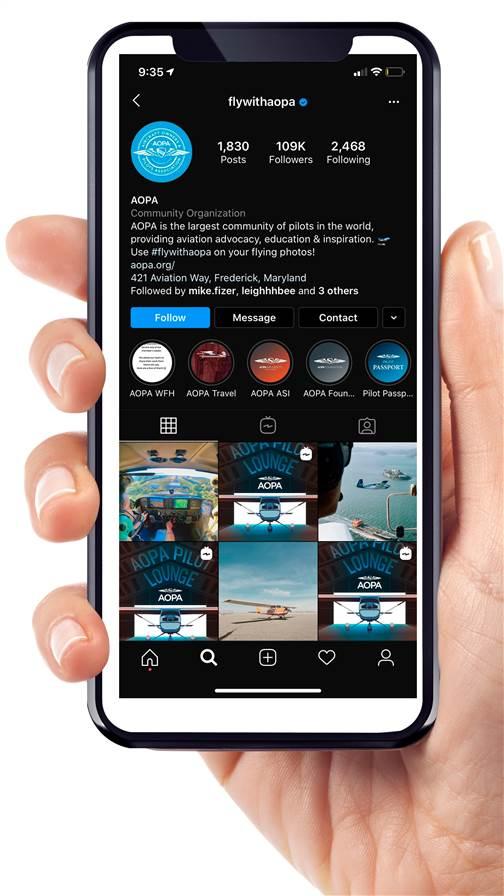Membership News & Notes: Breaking News
Keeping you informed with aopa.org
They ensure the top aviation news is sent directly to your inbox. The team produces six email newsletters, including AOPA ePilot and Flight Training, and makes daily updates to AOPA.org and the AOPA app.
Whenever there is breaking news—whether a new aircraft or product announcement, a natural disaster, or a global pandemic—the eMedia team keeps members informed on what will affect their flying, humanitarian efforts in which pilots can assist, and more. The latest example is the new coronavirus impact pages the team created. Here you’ll find the latest news on how the aviation community is coping, helping others, and responding to the pandemic. From personal pilot stories to industry innovations, this is the source for aviation-related coronavirus stories, collated on one easy-to-access page.
In normal times—or any time an event affects aviation—the team rallies to tell stories from an aviation perspective. AOPA.org has compiled special pages with stories on everything from airshow news to hurricane relief. The response to the COVID-19 pandemic is just another way AOPA serves its members—one compelling story at a time.
Email [email protected]
Top News
The coronavirus pandemic has significantly affected the general aviation community. Stay up to date with the latest news about flight operations, changes to scheduled events, and more on this breaking news briefs page.
- AOPA warns Congress of risks to FAA funding
- AOPA expects emergency currency rules to help
- Aerobridge calls for COVID-19 mission volunteers
- Skytypers: ‘We will get through this together’
- Not flying? Don’t cut insurance policy
- GA manufacturers pivot to coronavirus relief
- Airlines go from boom to bust
- GA fights for public benefit exemptions, accommodations
- Virgin Orbit launches lifesaving ventilator project
- FAA can’t waive insurance requirements
- FAA temporarily suspends enforcement of medical certificate expirations

AOPA Air Safety Institute
Keeping the odds in your favor
In survival scenarios, luck and hope have little to do with a positive outcome
By Alicia Herron
No one likes to consider the possibility of a forced off-airport landing—and the potential survival situation to follow. But as pilot in command, it is your job to prepare for the chance that you and your passengers could be in a life-or-death survival scenario, with only your preparation, training, and creativity to keep you alive.
The choices you make before takeoff can make a big difference when it comes to survival and rescue. Before cranking the engine, ask yourself if you’ve done everything possible to mitigate risk. Play the “What if…?” game: What if I crash? Have I briefed the crew and passengers? Did I pick the safest route? As much as we’d all like to think of ourselves as military-grade survivalists from hours of binge-watching Bear Grylls or Ron Swanson, we likely are not. Here are a few tips to increase your chances in a post-crash survival scenario:
Worst-case preparation matters. We all fly in different conditions over different terrain for different reasons, and every flight presents its own credible forced landing scenarios and risk profiles. There’s a misconception that survival planning is only needed for flights over rough terrain, but rescue after a forced landing in an urban area can take time, too.
Unplanned off-airport landings and crashes often result in serious injuries that disproportionately affect the people in the front of the airplane. If you get knocked unconscious after a forced landing, your passengers and their knowledge of what to do might be the only thing that will keep you alive. Planning your route, having the right clothing, and briefing everyone onboard about where to find and how to use survival and rescue gear can substantially influence the outcome of a forced landing in your favor.
Communication is critical throughout every flight. The more others know about your intended flight path and proposed departure and arrival times, the shorter you are likely to wait for help after an emergency landing. A good flight plan, keeping others in the loop on your whereabouts, and taking advantage of ATC services can improve your chances of a swift and successful search and rescue effort. This is true even of local or training flights.
If you choose not to use ATC services, at a minimum let a friend on the ground know your plans—you want someone to miss you if you don’t get in touch with them by a certain time. And taking that into consideration, make sure your ground contact is knowledgeable enough about aviation to know what next step to take if you become overdue.
Training and actions can determine your fate. Every emergency is different, and everyone will respond differently, but good training generally (and predictably) yields better results. Basic survival knowledge and the right equipment can help you better control your fate, and hands-on training is the best way to go. Seek this training out before you need it.
We all hope to never need to use our survival skills and gear, but we also know that hope is not a strategy. Prepare now to avoid regret later. Learn more about how you can prepare for the unlikely event of a survival situation after an off-airport landing with this safety advisor:
airsafetyinstitute.org/safetyadvisors/survive
Email [email protected]
Turn on your notifications
On your feed
Fly with AOPA
Back to normal
 Now is the perfect time to study for your next raiting, endorsement, or checkout. Life will return to normal. What are you getting ready for?
Now is the perfect time to study for your next raiting, endorsement, or checkout. Life will return to normal. What are you getting ready for?
#flywithaopa
Photo by @jesseheint
AOPA’s PILOT PASSPORT:
#ShareaFlight June challenge
Did you know June 29 is Social Media Day? (There’s a day for everything, isn’t there?) It’s an opportunity to share your love of flying. Accept the new challenge in the AOPA Pilot Passport program and share your flying experiences with others.
The June Share A Flight Challenge will award three participants with the most shares on social media—Facebook, Instagram, and/or Twitter—during the month of June. Each top sharer will receive a noise-canceling Bluetooth stereo headset.
The AOPA Pilot Passport Program on the AOPA app encourages pilots to check in at different types of airports, land at airports across your state, visit airports and aviation events across the country, and share your experiences by rating the airport, uploading photos, and posting comments on social media (use #AOPAPilotPassport in your posts).
Grounded because of COVID-19 restrictions? Share photos from past flights and let us know what you’re looking forward to when restrictions are lifted.
aopa.org/travel/pilot-passport
Looking for more?
Instagram: flywithaopa
Twitter: @aopa
Facebook: AOPA: your freedom to fly
AOPA Live
Post of the month
 Sharing the skies
Sharing the skies
Don’t forget to check in with your flying friends. #flywithaopa
Photo by @sjcspotter @krhvphotography
Tag @flywithaopa for your chance to be featured on this page.

Member Products and Services
Legally speaking: Aircraft and wildlife mergers
When two worlds collide
By Cristina Zambrana
Bird strike is the term given for events involving the collision of aircraft and avian. Bird strikes are common enough that the Aeronautical Information Manual has a section dedicated to their hazards (in AIM 7-4). But strikes with all types of wildlife are possible; we’ve even heard of midair strikes with fish jettisoned from eagles’ talons.
Pilots understand that “mergers” with wildlife come with command decisions. FAR 91.7 requires the pilot in command to discontinue the flight when unairworthy mechanical, electrical, or structural conditions occur. Pilots should consider whether a strike results in an in-flight emergency requiring immediate action (see FAR 91.3), and should not hesitate to declare an emergency if appropriate.
Once you’re safely on the ground after a strike, FAA Advisory Circular AC 150/5200-32B offers guidance on wildlife strike reporting procedures, including information on collecting and submitting remains for identification. To promote reporting on Form 5200-7, the FAA wildlife database is now available on FAA.gov/mobile. The FAA strongly encourages pilots to report a strike, but any person who witnesses or finds evidence of a wildlife strike may choose to report it. Reporting wildlife strikes will update the wildlife advisories to other aircraft and trigger required actions for airport managers, who have a duty to mitigate wildlife dangers.
After an aircraft sustains a strike, the PIC must ensure that any appropriate aircraft inspections and airworthiness signoffs are accomplished before further flights. Any wildlife remains recovered may be sent to the Smithsonian Institution’s Feather Identification Lab for species identification; this is useful to maintain safety around airports and to aid aircraft manufacturers in engineering safer designs.
In addition to being eligible for an FAA wildlife strike report, strikes may also require a report to the National Transportation Safety Board (NTSB). Both accidents and certain serious incidents require immediate NTSB notification. The strike may be an accident if it results in any person suffering death or serious injury or the aircraft receives certain substantial damage as defined in NTSB 830.2. Even if it’s not an accident, the strike may require NTSB reporting if it meets any of the serious incident criteria in NTSB 830.5, including flight control system malfunction or failure, or inability of any required flight crew to perform normal duties because of injury.
If the strike does not result in an accident that is reportable to the NTSB, the pilot may consider chirping about the event by making a de-identified report through the Aviation Safety Reporting System, administered by NASA. This may offer some benefits for the pilot and for the national airspace system. For more information on wildlife strikes in general, visit FAA’s wildlife strike fact sheet on FAA.gov.
Cristina Zambrana is an AOPA Legal Services Plan attorney.

 MEET ALYSSA COBB: AOPA SENIOR DIRECTOR, EMEDIA
MEET ALYSSA COBB: AOPA SENIOR DIRECTOR, EMEDIA

